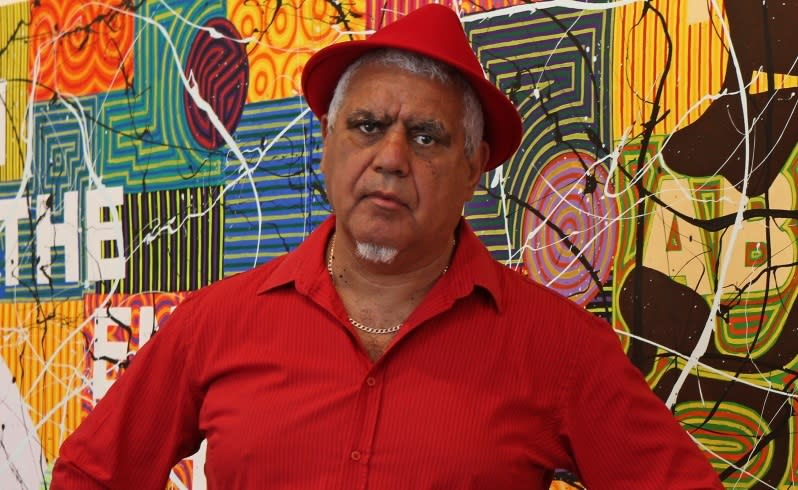Bell's tone mellows

He's colourful, larger than life, with a big laugh and a big message. Richard Bell - the Brisbane indigenous artist, political activist, provocateur and television presenter - is presenting his first solo exhibition in WA.
Leigh Robb, who is curating the Embassy show at the Perth Institute of Contemporary Arts for the Perth Festival, says Bell is one of the most influential artists in Australia.
"His art and writing have been a key reference point in national discussions about Aboriginal art for over 20 years, and he continues to ignite and force debates into public discussion," Robb says.
Bell says being a self-proclaimed show-off is essential in pushing the human rights and land rights of Aboriginals.
"If you're sitting in a dark corner no one is even going to be there to hear," he says. "Where other people jump up and down, I get on a trampoline."
The exhibition presents Bell's translation of his message across three forms of media.
The first is a recreation of the Aboriginal Tent Embassy, the protest camp set up in Canberra. Secondly, there is a trilogy of his recent controversial videos and thirdly, his highly acclaimed paintings that combine traditional indigenous mark-making with visual and textual messages reminiscent of comic books. In the painting Pecking Order, for instance, Bell positions a cartoon bubble above a woman with the text: "Thank Christ I'm not Aboriginal."
"Art is a really good forum for free speech," he says. "I've married the symbolism of the tent embassy with the opportunity to create an ambassadorial space where people can come along and have a discussion about things that are really important, which otherwise wouldn't be discussed."
His videos explore racism as an illness, rally Aboriginals to fight for a fair go and imagine a future where Aboriginals are the major landowners and political stakeholders of Australia.
Bell's depiction of indigenous victory includes a speech by the first Aboriginal president - after China buys Australia at a fire sale and gives it back to its traditional owners.
"Privilege is invisible," he says. "There is so much racism in this country. We should be at the top rung, but we're nailed to the bottom."
The presenter of the program Colour Theory on NITV, which interviews emerging indigenous artists and takes them back to their traditional country, Bell says he has a reputation as the angry black man.
"I'm certainly a lot better behaved these days. With age you get smarter, if not wiser. I was much more abrupt with people in my youth. I didn't suffer fools easily. Now I think, they come and they go. I'm much more laid-back about it. There's an old Aboriginal saying: 'I'm Aboriginal, I know how to wait.' I just wait for the f…… to move on."
He believes his reputation has cost him a place representing Australia at the Venice Biennale, despite being in the running four times. "I'm aiming for a record that can never be beaten for the amount of times being knocked back."
Born in Charleville, in south-west Queensland in 1953, Bell spent his early years living on an Aboriginal reserve with about 17 other families.
"There was one water tap between us. It was Third-World conditions. It was always spoken in our homes that we owned the land. I was quite puzzled as to why we were living on the outskirts of townships. Like most people I was brainwashed by the system," he says.
"It wasn't until I was in my twenties when I ran into the Black Power mob in Sydney I came to understand I shouldn't be thinking like a tenant, I should be thinking like the landlord. And that's how I think."
The winner of the 2003 National Telstra Aboriginal and Torres Strait Islander Art Award, and with exhibitions around the world, Bell has come far since his early days producing works for the tourist market.
"I didn't take a career path with a university education. We're called self-taught, but I think that's such a misnomer. Basically, my art education was finding people who I thought knew about art, and having discussions with them. I would try to get them aside as often as I could, and pump them for information. I'm sure I annoyed a lot of people," he laughs.
South African artist William Kentridge, who shares a similar stature politically with Bell, is exhibiting The Refusal of Time concurrently at PICA.
The two artists showed together previously at the 2008 Sydney Biennale where Bell says he had the opportunity to watch Kentridge in rehearsal for his performance there.
"I spent a few hours watching him. He was methodical and persistent. It made me change the way I was working. He's been at it for so long and still doing it with so much passion, it inspired me to work harder."
With so many facets to his long career, it would certainly seem Bell, too, is passionate, methodical and, make no mistake, persistent.
His greatest desire is for his works to be a catalyst for wider discussion where questions are raised and answers sought. "I want to inspire a questioning mind, even if it is momentarily."

